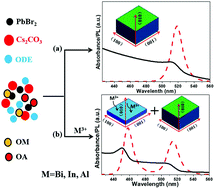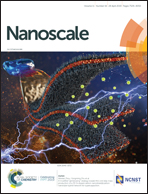Trivalent ion mediated abnormal growth of all-inorganic perovskite nanocrystals and their divergent emission properties†
Abstract
In this work, a new trivalent ion-mediated one-pot synthetic protocol is reported to create two well-defined optical absorbance and photoluminescence (PL) emissions in all-inorganic halide perovskite nanocrystals (NCs). The foreign M3+ cations (M = Bi, Al, In), typically from BiBr3, BiFeO3, BiCl3, AlBr3 or InBr3, function as capping ligands for generating a growth-constrained thinner nanoplatelet (NPL) population displaying the quantum confinement effect. The formation mechanism of the growth-constrained NPLs is proposed based on density functional theory (DFT) on the different slab energy of the representative NPLs achieved in the presence of Bi3+ ions and the density of states (DOS) of the supposed bulk perovskites. Notably, the formation of two groups of NCs with different sizes allows for the generation of dual optical absorbance and PL emissions. The influence of the M : Pb molar ratios on the precursors is systematically elucidated, from which the relative intensity and position of each PL emission can be fine-tuned. By virtue of the representative NPLs with well-defined green and blue emissions, the M3+-assisted synthetic protocol provides a facile and cost-effective route for producing unique NCs and nanostructures for optoelectronic device applications.



 Please wait while we load your content...
Please wait while we load your content...